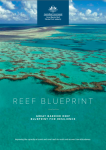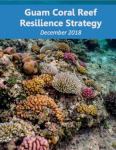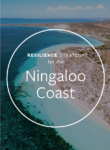RBM in Practice
Managers all over the world are integrating resilience-based management (RBM) concepts into their work and planning for the future using information from resilience assessments to manage integrated social-ecological systems. Below are a few examples of RBM planning and practice. Explore the following websites and presentations to see how RBM is being applied around the world.
Australia: Great Barrier Reef Marine Park Authority The Great Barrier Reef Marine Park Authority has increasingly been working to build resilience of the Great Barrier Reef to a changing climate. To do this, the Great Barrier Reef Marine Park Authority has developed a Reef Blueprint for Resilience in partnership with national and international experts, which guides implementation of existing and emerging RBM initiatives in the Marine Park. It is the primary output of a 2017 summit attended by marine park managers, Traditional Owners, government agencies, research institutions, industry groups, coral reef users, and other stakeholders. The Blueprint is designed around 10 key initiatives focused on delivering maximum benefits for reef resilience.
The Great Barrier Reef Marine Park Authority has increasingly been working to build resilience of the Great Barrier Reef to a changing climate. To do this, the Great Barrier Reef Marine Park Authority has developed a Reef Blueprint for Resilience in partnership with national and international experts, which guides implementation of existing and emerging RBM initiatives in the Marine Park. It is the primary output of a 2017 summit attended by marine park managers, Traditional Owners, government agencies, research institutions, industry groups, coral reef users, and other stakeholders. The Blueprint is designed around 10 key initiatives focused on delivering maximum benefits for reef resilience.
Watch a presentation from Great Barrier Reef Marine Park Authority and download the presentation PDF:
USA: NOAA Coral Reef Conservation Program

NOAA’s Coral Reef Conservation Program (CRCP) seeks to improve understanding of coral reef ecosystems, reduce adverse impacts of human activities, conduct interventions and restoration at scale, and increase local capacity to manage coral reefs.
NOAA’s CRCP Strategic Plan was developed to guide the agency's future coral reef research and conservation efforts using the principles of resilience-based management. It outlines refined strategies to increase resilience to climate change, improve fisheries' sustainability, and reduce land-based sources of pollution, while adding a new focus of work to restore viable coral populations at ecosystem scales.
NOAA’s CRCP supports states and territories as they implement coral reef management programs and provides funding for projects to address coral reef management priorities identified by the reef management community in each jurisdiction. Examples of such projects include: Resilience Action Plan for Florida’s Coral Reef, NOAA’s Coral Reef Watch, and the Florida Keys’ Bleach Watch.
Watch a presentation from NOAA Coral Reef Conservation Program and download the presentation PDF:
USA: Guam Coral Reef Resilience Strategy The Guam Coral Reef Resilience Strategy (GRRS) is an adaptive, strategic framework to guide coral reef management on Guam. The goal of the GRRS is to address local stressors and enhance the resilience of Guam’s coral reef ecosystems and human communities to the impacts of climate change by 2025. The GRRS was developed by 56 individuals, representing 16 local and federal agencies, educational and research institutions, non-profit organizations, and private sector entities during the course of three years. In June 2019, the Government of Guam formally adopted the GRRS, calling for its immediate implementation.
The Guam Coral Reef Resilience Strategy (GRRS) is an adaptive, strategic framework to guide coral reef management on Guam. The goal of the GRRS is to address local stressors and enhance the resilience of Guam’s coral reef ecosystems and human communities to the impacts of climate change by 2025. The GRRS was developed by 56 individuals, representing 16 local and federal agencies, educational and research institutions, non-profit organizations, and private sector entities during the course of three years. In June 2019, the Government of Guam formally adopted the GRRS, calling for its immediate implementation.
Australia: Ningaloo Resilience Strategy The Ningaloo Coast is recognized as a UNESCO World Heritage Area. While the area is characterized by low levels of development, as well as established legislative and regulatory protection, climate change and human pressures are likely to significantly impact the condition of Ningaloo Reef within the next 20 years.
The Ningaloo Coast is recognized as a UNESCO World Heritage Area. While the area is characterized by low levels of development, as well as established legislative and regulatory protection, climate change and human pressures are likely to significantly impact the condition of Ningaloo Reef within the next 20 years.
As a result, a Resilience Strategy for the Ningaloo Coast was developed in partnership with the Resilient Reefs Initiative (RRI) to support capacity of the reef ecosystem and the individuals, businesses, and communities that depend upon it to survive, adapt, and recover from the stresses and shocks that they will experience in the future. The Resilience Strategy is informed by existing research, management plans, and policy documents, as well as the experience and knowledge of Traditional Owners, local councils, other management authorities, scientists, local business owners, community members, specific interest groups and industries, and global resilience experts.
The Resilient Reefs Initiative is a collaboration between the Great Barrier Reef Foundation, BHP Foundation, UNESCO World Heritage Marine Programme, The Nature Conservancy’s Reef Resilience Network, Resilient Cities Catalyst, and AECOM. RRI is piloting a new RBM framework integrating social and ecological reef resilience by bringing together local communities, reef managers, and resilience experts. This approach puts people at the center of decision-making, drawing on RBM principles to innovate and build capacity to address the challenges facing today’s reefs.
RBM Guidance from Managers, Scientists, and Policy-Makers
At the 2019 International Coral Reef Initiative (ICRI) General Meeting, managers, scientists, and policy makers brainstormed and discussed key challenges, opportunities, communication needs, and capacity-building priorities to plan and implement RBM. Below are highlights of their observations, ideas, and recommendations, which prompted ICRI to create an ad hoc committee to identify support and develop best-practice guidance on actions that will enable members to tailor and scale up RBM to meet local, national and global needs.
Below is a list of potential opportunities RBM can provide for managers as well as opportunities to increase the adoption of RBM:
- Empowers practitioners by validating the importance of local actions, providing an opportunity to manage reefs in the face of climate change, and linking ecosystem management and human well-being.
- Uses existing reef monitoring assessments (e.g. vulnerability and resilience assessments) to inform priority areas for management.
- Allows for the management of multiple impacts, providing cumulative benefits (including economic benefits) from one action, meaning it is an efficient and cost-effective approach.
- Promotes income and livelihood benefits (e.g. a healthy environment can result in increased income through tourism activities).
- Involves agencies and stakeholders that are not usually engaged in coral reef management, such as private sector industries, to bring new perspectives and resources.
- May allow increased access to climate funding.
- Opportunity to institutionalize RBM into national policy and plans.
Understanding challenges to implementing RBM ahead of time may help with planning and execution:
- Balancing short-term outcomes and long-term timeframes: ecological recovery processes and adaptation within social systems often occur over years or decades, and this uncertainty and long timeframe to see results can be difficult to communicate to various stakeholder groups and may impact political will to implement RBM.
- Political acceptance of RBM: a lack of political will or understanding, or resistance from decision-makers to change current management processes, can make RBM challenging to implement.
- Communication of scientific data: ineffective communication between scientists, managers, and policy makers can occur when different “languages” are used to describe the importance of conserving reefs and RBM or results from scientific studies. (See Communication tab.)
- Holistic management of socio-ecological systems: managers may lack the capacity (e.g., scientific expertise, skills, funding, and time) needed to assess, manage, and monitor multiple social and ecological aspects of the system.
- Managing for uncertainty: RBM requires proactively managing to build resilience to future changes despite uncertainty and potential alternative scenarios.
- Perceived trade-off between ecological and social values: a key component of RBM is the coupling of social-ecological systems in driving resilience and transformation, which requires communicating the importance of both ecological and social values and working with a broad range of stakeholders.
- Lack of willingness to fail: Part of RBM is experimenting with new approaches, which requires acceptance from all parties for trial and error, adaptation, and learning from failures.
Challenges to implementing RBM often involve communicating the value and goals of RBM and setting the correct expectations with various stakeholder groups. Successful implementation of RBM requires a multi-pronged communications effort between management agencies, scientists, communities, industry, and politicians with the help of communications experts. Recommendations include:
- Target your message to your audience: Understand who your audience is and what matters most to them; “touch their hearts and minds” by developing messages, telling stories, and using analogies that resonate with your audience; and make sure messages are simple and accessible.
- Deliver messages through trusted messengers (voices) who resonate with your target audience.
- As a management community, identify key shared messages around resilience and RBM and brand them. The word “resilience” means different things to different people. Key messages should be adapted, as needed, based on what your audience knows about this topic. It’s essential to explain resilience and RBM in terms of concepts and words your audience understands.
For more messaging tips, click here.
Training for different stakeholder groups is seen as a key opportunity for building capacity to implement RBM effectively. Examples include building local community knowledge through communications and citizen science programs. Management agencies may require technical training to equip them to conduct and describe the process and benefits of RBM to key decision-making authorities. Other specific recommendations include:
- Help leaders understand RBM’s goals, approach, and the benefits it can bring.
- Help the private sector (e.g. banks and insurance companies) understand RBM, the science, and the role they can play to further reef conservation and management.
- Provide managers and community groups with training on sustainable financing, stakeholder analysis, how to access funds and develop partnerships, and other priority topics.
- Foster a community of practice that can promote knowledge sharing and help this continue to advance.

